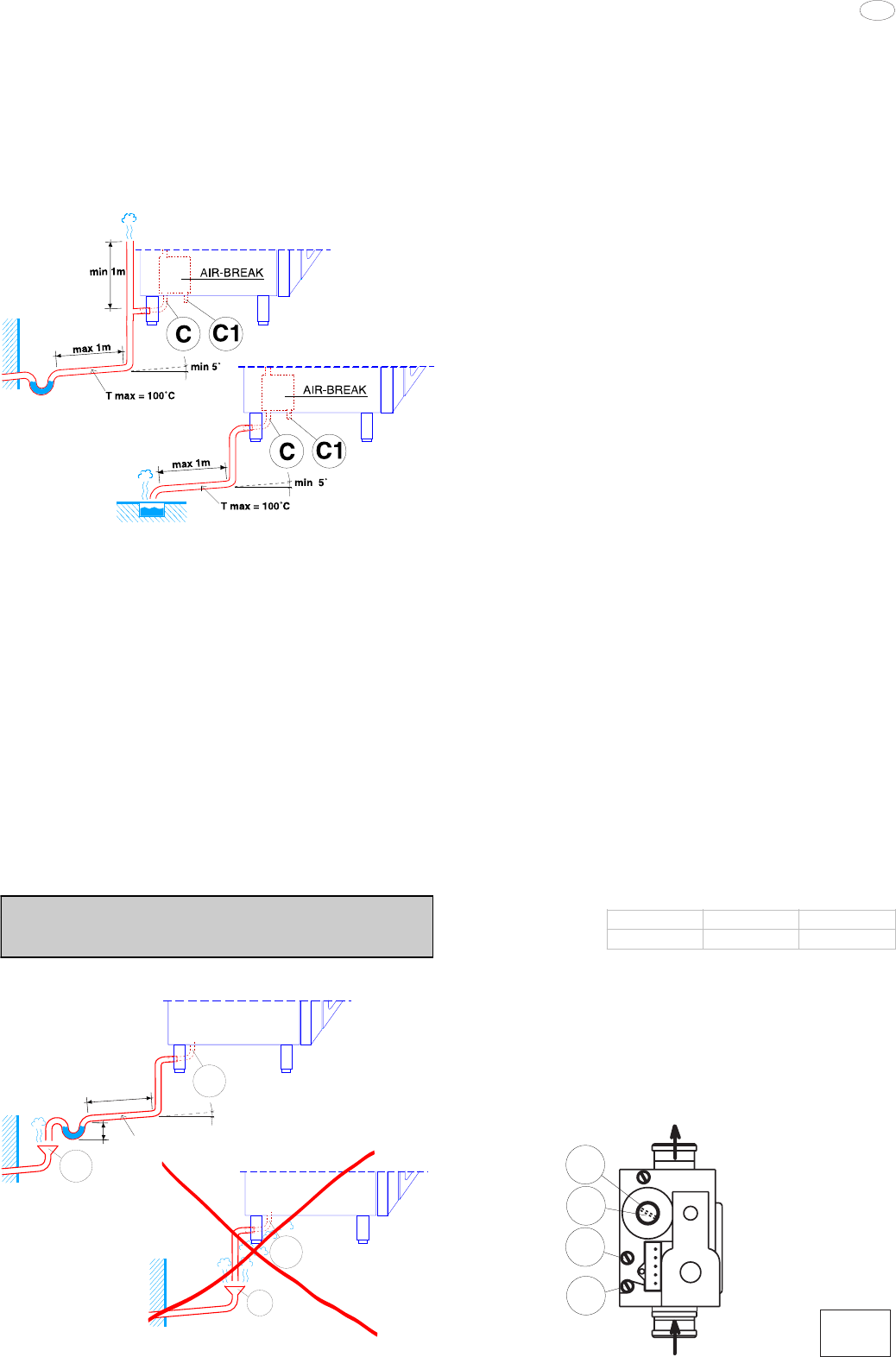
17
USA
5938 036 01
resist temperatures of up to at least 212°F (100°C). Avoid re-
strictions in the case of flexible hose pipes, do not fit elbows on
metal pipes anywhere along the drainage line. Also avoid
horizontal sections in which water might collect (minimum gra-
dient 5%).
WARING: BLOCKING THE DRAIN IS HAZARDOUS.
C - Oven drain
C1 - Safety outlet
Important:
- Do not obstruct the safety outlet C1.
- Do not connect the safety outlet C1 to the drainage system.
Note:
If water comes out of the AIR-BREAK (safety outlet C1) this means
the drain C is blocked. Any elimination of the obstruction must
be carried out by specialised technical personnel.
- OVEN level C -
Connect drain fitting “C” to a drain pipe of the same diameter
which is between 0.5 and 3 metres in length and is resistant to
temperatures of at least 100°C. The drain pipe must be siphoned
(height 80 mm) to an open drain “O” (“Air-Break”) or floor grating
(see Fig. 12b) in order to prevent any back-flow from the sewage
system from reaching the piping inside the oven or oven chamber.
Check the hoses and elbows on metal pipes for kinks or pinching
along the entire drain line and make sure the drain line has a
minimum gradient of 5° to prevent water from collecting inside
the
system.
Important: The drain system must be installed so that any
vapours from the open drain do not enter the aeration vents
under the appliance.
OK
min 5°
C
AIR-BREAK
T max = 100°C
max 3m
0,08 m
min 0,5m
O
C
AIR-BREAK
O
KO
6. GAS CONNECTION
6.1 WARNINGS
• Make sure the appliance is set up for the type of gas with
which it will be supplied.
• The gas inlet connector is yellow in colour.
• Before installing consult your local gas utility company to check
the compatibility between the available supply and the
consumption of the appliance.
• Before hooking up the appliance to the gas pipeline remove the
plastic protective plug from the gas connector.
• Fit a rapid gas shut-off cock upline from the appliance in an
easily accessible position.
• On completion of installation, use soapy water to check gas
connections for leaks.
• It is not possible to adjust the combustion air ventilation capacity.
• If the appliance is hooked up to a supply with a different gas type
with respect to the factory setting, after making the necessary
changes check that it is working correctly (see heading 8
"Operation Check").
6.2 NOMINAL HEAT OUTPUT
For data concerning the nominal heat output refer to "Technical
Data" in Table 1.
This parameter is determined by the pressure of the gas supply
and the diameter of the gas valve diaphragm (nozzle).
The appliance nominal heat output must always be checked (by
the authorised installer or by the gas utility company), both in the
case of new installations or following maintenance work.
It is strictly prohibited to make changes to the nominal heat output.
6.3 CHECKING THE SUPPLY PRESSURE (Fig. 2a)
The gas supply pressure must be measured upline from the gas
shut-off cock with the appliance operating, using a pressure
gauge with minimum resolution of 0.1 mbar and proceeding as
outlined below:
1) Remove the left hand side panel to gain access to the gas valve;
2) Loosen sealing screw "C" from the gas valve pressure test point
and connect the pressure gauge hose in its place;
3) Open the gas shut-off cock;
4) Start a mixed cooking cycle (see "Instructions for use") in
such a way that all the burners can be lit;
5) Check that the pressure reading is within the values given in
the following table:
GAS TYPE PRESSURE (MBAR)
Nom. Min. Max.
NATURAL
PROPANE
7"wc (17,4mbar) 3"wc (8,7mbar) 10"wc (26,1mbar)
11"wc (27,4mbar) 8"wc (19,9mbar) 13"wc (32,3,4mbar)
If the values are not within the values shown in the table the
appliance will not function.
In this case inform your gas utility company of the problem;
6) Once you have measured the supply pressure stop the cooking
cycle and close the gas shut-off cock.
7) Disconnect the pressure gauge and carefully refit and tighten
sealing screw "C";
8) Refit the previously removed side panel.
C
E
neywell_sigma
D
E1
2a


















